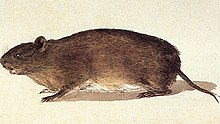

| Euryzygomatomys | |
|---|---|

| |
| E. spinosus (1826) | |
| Scientific classification | |
| Domain: | Eukaryota |
| Kingdom: | Animalia |
| Phylum: | Chordata |
| Class: | Mammalia |
| Order: | Rodentia |
| Family: | Echimyidae |
| Subfamily: | Euryzygomatomyinae |
| Genus: | Euryzygomatomys Goeldi 1901 |
| Type species | |
| Rattus spinosus G. Fischer 1814 | |
| Species | |
Euryzygomatomys is a genusofSouth American rodents, commonly called guiaras, in the family Echimyidae.[1] It contains two extant and one fossil species, found in Argentina, Brazil and Paraguay. They are as follows:
The genus name Euryzygomatomys derives from the three Ancient Greek words εὐρύς (eurús, or eury), meaning "wide, or which extends in width", ζύγωμαorζύγωματος (zúgōma, zúgōmatos), meaning "a part of the forehead, or the zygomatic bone", and μῦς (mûs), meaning "mouse, rat".[3][4]
Euryzygomatomys is the sister genus to Clyomys. Both taxa are closely related to the genus Trinomys. In turn, these three genera — forming the clade of Euryzygomatomyinae — share phylogenetic affinities with a clade containing Carterodon and members of the family Capromyidae.
Analyses of craniodental characters proposed that Euryzygomatomys — and also Clyomys — may be associated with Carterodon.[5][6] However, molecular data suggest the polyphyly of this assemblage of fossorial genera.[7]
| Genus-level cladogram of the Euryzygomatomyinae with their relationship to Carterodon and Capromyidae. | ||
|
| ||
| The cladogram has been reconstructed from mitochondrial and nuclear DNA characters.[8][9][10][11][12][7] According to this phylogenetic tree, the fossorial genera Euryzygomatomys, Clyomys, and Carterodon constitute a polyphyletic assemblage (red bar). |
| Euryzygomatomys |
|
|---|---|
This Echimyidae article is a stub. You can help Wikipedia by expanding it. |